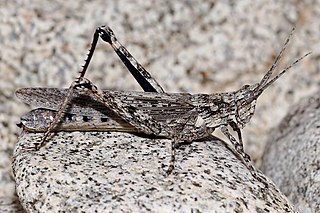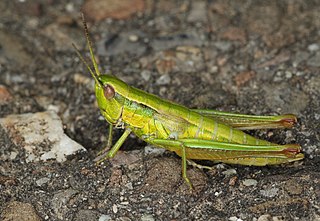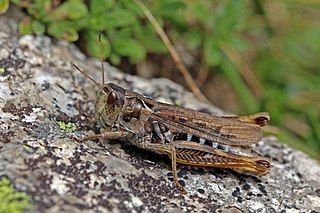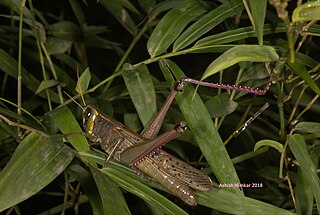
The Acrididae are the predominant family of grasshoppers, comprising some 10,000 of the 11,000 species of the entire suborder Caelifera. The Acrididae are best known because all locusts are of the Acrididae. The subfamily Oedipodinae is sometimes classified as a distinct family Oedipodidae in the superfamily Acridoidea. Acrididae grasshoppers are characterized by relatively short and stout antennae, and tympana on the side of the first abdominal segment.

Bandwings, or band-winged grasshoppers, are the subfamily Oedipodinae of grasshoppers classified under the family Acrididae. They have a worldwide distribution and were originally elevated to full family status as the Oedipodidae. Many species primarily inhabit xeric weedy fields, and some are considered to be important locusts:

The grasshopper subfamily Acridinae, sometimes called silent slant-faced grasshoppers, belong of the large family Acrididae in the Orthoptera: Caelifera.

Tetrigidae is an ancient family in the order Orthoptera, which also includes similar families such as crickets, grasshoppers, and their allies. Species within the Tetrigidae are variously called groundhoppers, pygmy grasshoppers, pygmy devils or "grouse locusts".

Gomphocerinae, sometimes called "slant-faced grasshoppers", are a subfamily of grasshoppers found on every continent but Antarctica and Australia.

Gomphocerini is a tribe of grasshoppers of the family Acrididae.

Pyrgomorphidae is a family of grasshoppers in the order Orthoptera; it is the only family in the superfamily Pyrgomorphoidea, with a pan-tropical distribution. Their name is probably derived from pyrgos meaning "tower": a reference to the form (morph) of the head in the type genus Pyrgomorpha and other genera.

Acridini is a tribe of insects in the subfamily Acridinae, of the insect family Acrididae and are sometimes called "silent slant-faced grasshoppers". It was firstly described as Truxalis Conicus in 1781
Eumastacidae are a family of grasshoppers sometimes known as monkey- or matchstick grasshoppers. They usually have thin legs that are held folded at right angles to the body, sometimes close to the horizontal plane. Many species are wingless and the head is at an angle with the top of the head often jutting above the line of the thorax and abdomen. They have three segmented tarsi and have a short antenna with a knobby organ at the tip. They do not have a prosternal spine or tympanum. Most species are tropical and the diversity is greater in the Old World. They are considered primitive within the Orthoptera and feed on algae, ferns and gymnosperms, the more ancient plant groups.

Pamphagidae is a family of grasshoppers belonging to the superfamily Acridoidea. The species in this family can be found in Africa, Europe and Asia.

Oxyini is one of two tribes of grasshoppers in the subfamily Oxyinae. Some genera previously listed here are now placed in the subfamilies Caryandinae and Hemiacridinae.
The Cyrtacanthacridinae are a subfamily of Orthoptera: Caelifera in the family Acrididae. They are sometimes referred-to as bird locusts, criquets voyageurs in French-speaking Africa, and Knarrschrecken in German.

Dociostaurus is a genus of grasshoppers in the family Acrididae, subfamily Gomphocerinae and typical of the tribe Dociostaurini. Species are found in Africa, southern Europe and Asia, and includes the economically important Moroccan locust.

The Orthacridinae are a sub-family of grasshoppers in the family Pyrgomorphidae. Species are found in: Central America, Africa, Asia, Australia and certain Pacific Islands. The type genus is Orthacris and the taxon proposed by Bolívar in 1905.

Phlaeoba is a genus of grasshoppers in the family Acrididae and subfamily Acridinae. The recorded distribution of species includes: India, China, Indo-China and Malesia.
Gonista is a genus of grasshoppers in the family Acrididae, subfamily Gomphocerinae, and tribe Ochrilidiini; species are distributed in China and SE Asia.

Tagasta is a genus of grasshoppers in the family Pyrgomorphidae, subfamily Pyrgomorphinae and tribe Tagastini. Species can be found around the Himalayan mountains, southern China, Indo-China and Malesia. It was described in 1905.

The Phlaeobini are a tribe of grasshoppers in the subfamily Acridinae. The recorded distribution of genera includes: Africa, the Middle East and Asia.

Choroedocus is a genus of grasshoppers in the subfamily Catantopinae, not assigned to any tribe. Species can be found in South Africa, India and Indo-China.
Megaulacobothrus is a genus of grasshoppers in the tribe Stenobothrini. Species have been recorded from northern and Temperate Asia.















